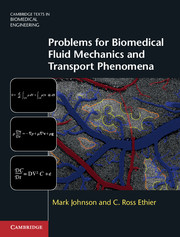Book contents
- Frontmatter
- Dedication
- Contents
- Preface
- 1 Problem solving
- 2 Conservation of mass and theReynolds transport theorem
- 3 Steady and unsteadyBernoulli equation and momentum conservation
- 4 Viscous flow
- 5 Momentum boundary layers
- 6 Piping systems, frictionfactors, and drag coefficients
- 7 Problems involving surface tension
- 8 Non-Newtonian blood flow
- 9 Dimensional analysis
- 10 Statistical mechanics
- 11 Steady diffusion and conduction
- 12 Unsteady diffusion and conduction
- 13 Convection of mass and heat
- 14 Concentration and thermal boundarylayers
- 15 Mass and heat transfer coefficients
- 16 Osmotic pressure
- Appendix A Material properties of fluids
- Appendix B Transport equations
- Appendix C Charts
- References
- Permissions
16 - Osmotic pressure
(6 problems)
Published online by Cambridge University Press: 18 December 2013
- Frontmatter
- Dedication
- Contents
- Preface
- 1 Problem solving
- 2 Conservation of mass and theReynolds transport theorem
- 3 Steady and unsteadyBernoulli equation and momentum conservation
- 4 Viscous flow
- 5 Momentum boundary layers
- 6 Piping systems, frictionfactors, and drag coefficients
- 7 Problems involving surface tension
- 8 Non-Newtonian blood flow
- 9 Dimensional analysis
- 10 Statistical mechanics
- 11 Steady diffusion and conduction
- 12 Unsteady diffusion and conduction
- 13 Convection of mass and heat
- 14 Concentration and thermal boundarylayers
- 15 Mass and heat transfer coefficients
- 16 Osmotic pressure
- Appendix A Material properties of fluids
- Appendix B Transport equations
- Appendix C Charts
- References
- Permissions
Summary
Consider a membrane of thickness 10 μm that has a number of tiny cylindrical pores (of radius 10 nm) passing through it. The density of pores in the membrane is such that the porosity (fractions of water-filled space) of the membrane is 0.1%.
(a) Find the hydraulic conductivity (Lp, flow rate per unit area per unit pressure drop) of this membrane.
(b) Consider a 4 mM solution of a large protein on one side of this membrane and physiologic saline on the other, with the same pressure on both sides of the membrane. Assume that the protein is sufficiently large that it cannot pass through the membrane and that van ’t Hoff’s law holds for this solute. Calculate the initial flow rate of saline through a membrane of area 5 cm2 at a temperature of 300 K.
The graph shown in the figure overleaf is adapted from a 1927 paper [16] in which Landis proved the existence of Starling’s phenomenon by occluding capillaries. The ordinate is the volume of fluid leaking out of (or re-entering) the capillary per unit capillary wall area, j. Although it is not precisely true, for the purposes of this question you may assume that the reflection coefficient of this capillary wall to plasma proteins is unity.
(a) Assuming that p – Π for the interstitium is –5 cm H2O, estimate the plasma osmotic pressure (Π) from the figure. Note that the plasma proteins are the main species influencing the osmotic pressure difference across the capillary wall.
(b) Estimate the filtration coefficient Lp for this capillary.
(c) Consider a capillary 0.05 cm long of diameter 8 µm, for which the arteriolar and venular luminal pressures are 25 and 5 cm H2O, respectively. Assume that Lp and Π are constant and that the pressure drop varies linearly along the capillary. What is the net rate of fluid loss (gain) from the capillary?
- Type
- Chapter
- Information
- Problems for Biomedical Fluid Mechanics and Transport Phenomena , pp. 151 - 155Publisher: Cambridge University PressPrint publication year: 2013



